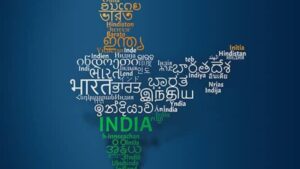Boasting as one of the oldest civilizations of the world, contemporary India is home to a multitude of regional and local dialects under the paternity of English and maternity of Hindi. The Indian linguistic culture assimilated various languages and dialects throughout centuries as it came with her invaders, conquerors and imperialist masters who established empires, kingdoms and dominions. No other contemporary culture other than India can gasconade the meticulous particularization of rich language systems, be it Indo-Aryan, Dravidian, Austro-Asiatic or Tibeto-Burman.
The continuous invasions of India warranted that any particular language will not be overwhelmingly dominant. Indian linguistic diaspora got aesthetically refined since the Aryanization and subsequent Rajputization of Indian plains as well as the successive Genghisid-Timurid influence adopting Persian and Urdu as well. Indian court, inter-regional and social languages have evolved from Classical Vedic Sanskrit to Prakrit, Apabhramsa, Arabic, Brajbhasha, Persian, Urdu, Hindi and finally, Anglo-English. Broadly speaking, Hindi displaced Sanskrit, Persian displaced Hindi and Anglo-English displaced Persian. Anglo-English transitioned to English and became the lingua franca of the intellectual elite.
But if we look down upon the South India’s Dravidian language divisions of Andhra and Dravida, which blended together to give rise to the modern Dravidian languages, Telugu has come from Andhra. Tamil, Malayalam and Kannada arose from Dravida. Through the ages, despite Arabic trade relationships and Mughal invasions penetrating the Dravidian heartlands, the Dravidian languages have maintained their unbroken antiquity.
Which brings us next to the question of linguistic sovereignty. With such a philological, phonetic and syntactical diversity, is it right to league a nation under a centralized and integrated language system? Having attained independence from the British in 1947, Indian leaders chose Hindi as the official language of India in the hope that it would facilitate regional communication and encourage national unity. The Constitution of India was framed with the provision that the official language of the Union would be Hindi in Deva Nagari script. Indian government designated states based on linguistic preponderance. For the most part, each state has a majority language which takes precedence over the many others which also co-exist in the region. They were aware of many of the difficulties inherent with instating a single language in India’s multi-lingual environment, and they accordingly laid out a clear timeline and plan for introducing Hindi and phasing English out. Despite this planning, Hindi and English today still share their status as official language and working language.
As India evolved civil-politically, geo-politically and religio-politically, Linguistic sovereignty gave way to Linguistic Nationalism, the imposition of one language on speakers of other languages and dialects. Many states revolted at the idea of a national language displacing their linguistic cultural heritage. The major Indian languages are all highly developed and have impressive literary traditions of their own. People have great pride in their own languages and fail to see why Hindi should be given a dominance which it cannot claim on its own.
The Constitution of India was framed with the provision that the official language of the Union would be Hindi in Deva Nagari script.
With a diverse cultural past and as an emerging power in the 21st century world, India and her leaders have to account for the diverse demographic citizenry with their unique cultural identity and take suitable steps to preserve them under a united federation. The promotion of all languages and dialects becomes paramount to maintain equal educational and employment opportunities for speakers of all languages. Hundreds of millions of people continue to think, write and dream in the languages incorporated in the Eighth Schedule to the Constitution of India. India is one country in her social fabric despite the assimilation and integration of diverse sociological groups and their related propriety, etiquette and decorum. This diverse cultural and linguistic identity of the people of India should be their cohesive sturdiness, not impuissance.
Dr Shadab Ahmed is an Oral & Maxillofacial Surgeon, and a translator of several books on historical poetry.













